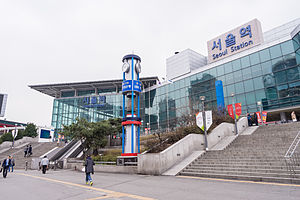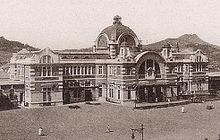Seoul Station
Seoul 서울 | |
|---|---|
 | |
| Korean name | |
| Hangul | |
| Hanja | 서울驛 |
| Revised Romanization | Seoul-yeok |
| McCune–Reischauer | Sŏul-yŏk |
| General information | |
| Location | Bongnae-dong and Dongja-dong, Seoul South Korea |
| Coordinates | 37°33′11″N 126°58′21″E / 37.55319°N 126.97260°ECoordinates: 37°33′11″N 126°58′21″E / 37.55319°N 126.97260°E |
| Operated by |
|
| Construction | |
| Structure type | At-grade and underground (Subway and AREX) |
| History | |
| Opened | July 8, 1900 (original station building) |
Seoul Station is a major railway station in Seoul, the capital of South Korea. The station is served by the Korail Intercity Lines and the commuter trains of the Seoul Metropolitan Subway.
Services[]
KTX[]
Seoul Station is the terminus of most KTX trains including:
- All trains along the Gyeongbu High Speed Line to Busan, Daejeon, Daegu, Pohang, Masan and Jinju
- All trains exclusively Honam High Speed Line and Jeolla lines to Gwangju, Mokpo, Suncheon and Yeosu-Expo.
- All trains along the Gyeonggang line to Pyeongchang, Jinbu, Gangneung and Donghae; and
- All KTX trains operating along sections of the conventional Gyeongbu line.
Some KTX services operating along sections of the conventional Honam Line bound for Gwangju, Mokpo and Yeosu arrive and depart Yongsan Station.[1]
ITX-Saemaeul[]
Seoul Station is the terminus of all ITX-Saemaeul trains along the Gyeongbu and Gyeongjeon Lines to Busan, Daejeon, Daegu, Pohang, Masan and Jinju. ITX-Saemaeul trains on the Honam and Jeolla lines arrive and depart Yongsan Station. ITX-Saemaeul trains to the east of Korea serve Cheongnyangni Station.[2]
Mugunghwa-ho[]
Seoul Station is the terminus of all Mugunghwa-ho trains along the Gyeongbu and Gyeongjeon Lines to Busan, Daejeon, Daegu, Pohang, Masan and Jinju; along the and along the Chungbuk Line to Jecheon. Mugunghwa-ho trains on the Honam and Jeolla lines arrive and depart Yongsan Station. Mugunghwa-ho trains to the east of Korea serve Cheongnyangni Station.[3]
Korail Tourist Trains[]
Seoul Station is the terminus of a number of Korail's tourist trains, including:
- The DMZ train to Dorasan and Baekmago[4]
- The O-train which loops the centre of the peninsula via Jecheon, Buncheon and Cheoram[5]
- The S-train to Yeosu[6]
AREX Airport Railway[]
AREX operate two trains from Seoul Station. AREX Express trains run non-stop to Incheon Airport stopping only at Incheon Terminal 1 and Incheon Terminal 2.[7] AREX All-Stop trains are commuter style trains that stop 11 times, including at Seoul's Gimpo Airport.[8]
AREX Express passengers have exclusive access to Seoul Station's City Air Terminal which allows passengers travelling on most Korean airlines from Incheon Airport to check bags and receive boarding passes before boarding the train. Access to the underground Airport Railroad Station and City Air Terminal is either from the central station concourse or via a dedicated drop off area and car park on the west side of the station.
Seoul Subway[]
Seoul Subway serves the station with Line 1 and Line 4, and an hourly train on the Gyeongui–Jungang Line.
Around 2015, a large bus transfer center was built in front of the station's main entrance. It has about nine platforms that services different bus routes in Seoul. It is separated from the main roads with a barrier around the platforms. Yet having a rather complicated structure with many bus platforms, the transfer center is built in a simple manner as it is not a separate terminal building.[9]
Station layout[]
Korail[]
| ||||||
|---|---|---|---|---|---|---|
 | ||||||
| Location | 43–205, Dongja-dong, Yongsan-gu, Seoul (1 Namdaemunno) | |||||
| Owned by | Korea Rail Network Authority | |||||
| Operated by | Korail | |||||
| Line(s) |
| |||||
| Platforms | 14 + 1 Gyeongui–Jungang Line platform | |||||
| Tracks |
| |||||
| Construction | ||||||
| Structure type | Ground | |||||
| Other information | ||||||
| Station code | P313 (Gyeongui–Jungang Line) | |||||
| History | ||||||
| Opened | September 12, 1988 | |||||
| Passengers | ||||||
| ||||||
| ↑Sinchon |
| | | | | | | 1 | |
| Terminus |
| ↑ Sinchon |
| Seobu | | 14·13 | | 12·11 | | 10·9 | | 8·7 | | 6·5 | | 4·3 | | 2·1 | |
| Namyeong ↓ |
| Platform No. | Line | Train | Destination |
|---|---|---|---|
| 1 | Seoul SubwayGyeongui-Jungang Line | B Express·A Express·Local |
|
| 1·2 | Seoul Subway Line 1 | Former Cheonan·Sinchang Express A | unusing |
| 3·12 | Mainline trains
Gyeongbu Line |
KTX·ITX-Saemaeul·Mugunghwa-ho | |
| 13·14 | Mainline trains
Gangneung Line |
KTX |
AREX[]
| |||
|---|---|---|---|
 Entrance for AREX | |||
| Owned by | Korea Rail Network Authority | ||
| Operated by | Korail Airport Co. | ||
| Platforms | 2 | ||
| Tracks | 3 | ||
| Construction | |||
| Structure type | Underground | ||
| Other information | |||
| Station code | A01 | ||
| History | |||
| Opened | December 29, 2010 | ||
| Electrified | Yes | ||
| Passengers | |||
| 29,796[11] | |||
| |||
↑ Terminus ↑
| Local | Express |
Gongdeok ↓ / Incheon Int'l Airport Terminal 1 ↓
| Line | Train | Destination |
|---|---|---|
| ●AREX | Local Express |
Exit Only |
| ●AREX | Local |
|
| ●AREX | Express |
|
- Platform numbers are not assigned; instead, platforms are classified as "express" or "local"
Platform layout (AREX)[]
| AREX platform level | Eastbound local | ← AREX Local Alighting passengers only |
| Island platform, doors will open on the right | ||
| Westbound local | → AREX Local toward Incheon Int'l Airport Terminal 2 (Gongdeok) → | |
| Express | → AREX Express toward Incheon Int'l Airport Terminal 2 (Incheon Int'l Airport Terminal 1) → | |
| ← AREX Express Alighting passengers only | ||
| Side platform, doors will open on the right | ||
Seoul Metro[]
| |||||
|---|---|---|---|---|---|
 Line 1 platform | |||||
| Location | Bongnaedong 2-ga, Jung-gu (Line 1) Dongja-dong, Yongsan-gu (Line 4) Seoul | ||||
| Operated by | Seoul Metro | ||||
| Platforms |
| ||||
| Tracks |
| ||||
| Construction | |||||
| Structure type | Underground | ||||
| History | |||||
| Opened | August 15, 1974 (Line 1) October 18, 1985 (Line 4) | ||||
| Electrified | Yes | ||||
| Passengers | |||||
| |||||
| Platform | Line | Destination |
|---|---|---|
| Line 1 Platform | ||
| To Sinchang/Incheon | ●Line 1 | |
| To Soyosan | ●Line 1 |
|
| Line 4 Platform | ||
| To Danggogae | ●Line 4 |
|
| To Oido | ●Line 4 |
|
Platform layout (Seoul Metro)[]
| Line 1 platforms | Southbound | → Line 1 toward Incheon or Sinchang (Namyeong) → |
| Island platform, doors will open on the right | ||
| Northbound | ← Line 1 toward Soyosan (City Hall) | |
| Line 4 platforms | Northbound | ← Line 4 toward Danggogae (Hoehyeon) |
| Island platform, doors will open on the left | ||
| Southbound | → Line 4 toward Oido (Sookmyung Women's Univ.) → | |
History[]

The former Seoul station, Namdaemun Station, started operating in a 33 m2 (10 pyeong) wooden building in July 1900 with the extension of the Gyeongin Line north of the Han River. The Gyeongbu Line opened in 1905, and the Gyeongui Line opened in 1921 – both lines connecting to the station. The construction of the current "Old Seoul Station" began on June 1, 1922, and was finished on September 30, 1925.[12] In 1923, the station reverted to the name "Gyeongseong Station," when the name of the city of Seoul changed from Hanseong to Gyeongseong ("Keijo" in Japanese).
The station was renamed "Seoul Station" on November 1, 1947. The station was expanded throughout the post-Korean War era; the Southern Annex of Seoul Station was completed on December 30, 1957, and the Western Annex was completed on February 14, 1969. In 1975, the Korea National Railroad's office moved from Seoul Station to the new West Annex office. A raised walkway connecting the Seoul Station and the West Annex was completed in 1977, and Korea's first privately funded station was erected in 1988 in time for the Seoul Olympics. In 2004, a new terminal adjacent to the existing one was completed to coincide with the introduction of KTX high-speed rail service.[12]
See also[]
- Transportation in South Korea
References[]
- ^ "KTX | Seoul to Busan, Daeju etc. Train | Reviews, Photos & Information". trainreview.com. Retrieved October 12, 2020.
- ^ "TrainReview's Guide to ITX-Saemaeul trains".
- ^ "TrainReview's guide to Mugunghwa-ho trains".
- ^ "TrainReview's guide to the DMZ train".
- ^ "TrainReview's guide to the O-Train".
- ^ "TrainReview's guide to the S-Train (Seoul - Yeosu)". TrainReview.
- ^ "AREX Express | Seoul - Incheon Airport Train | Reviews, Photos & More". trainreview.com. Retrieved October 12, 2020.
- ^ "AREX All Stop | Seoul - Incheon Airport Train | Reviews, Photos & More". trainreview.com. Retrieved October 12, 2020.
- ^ "서울역 버스환승센터 - 회현동 - 36 tips". Foursquare.com. Retrieved September 13, 2018.
- ^ Monthly Number of Passengers between General Railroad Stations Archived October 8, 2014, at the Wayback Machine. Korea Transportation Database, 2013. Retrieved 2013-10-15.
- ^ Jump up to: a b c d Monthly Number of Passengers between Subway Stations Archived October 6, 2014, at the Wayback Machine. Korea Transportation Database, 2013. Retrieved 2013-10-15.
- ^ Jump up to: a b "History". Culture Station 284. Archived from the original on January 29, 2017. Retrieved August 10, 2012.
External links[]
- Railway stations in Seoul
- Railway stations opened in 1925
- Seoul Metropolitan Subway stations
- Historic Sites of South Korea
- Metro stations in Jung District, Seoul
- Metro stations in Yongsan District
- Korea Train Express stations
- 1925 establishments in Korea

